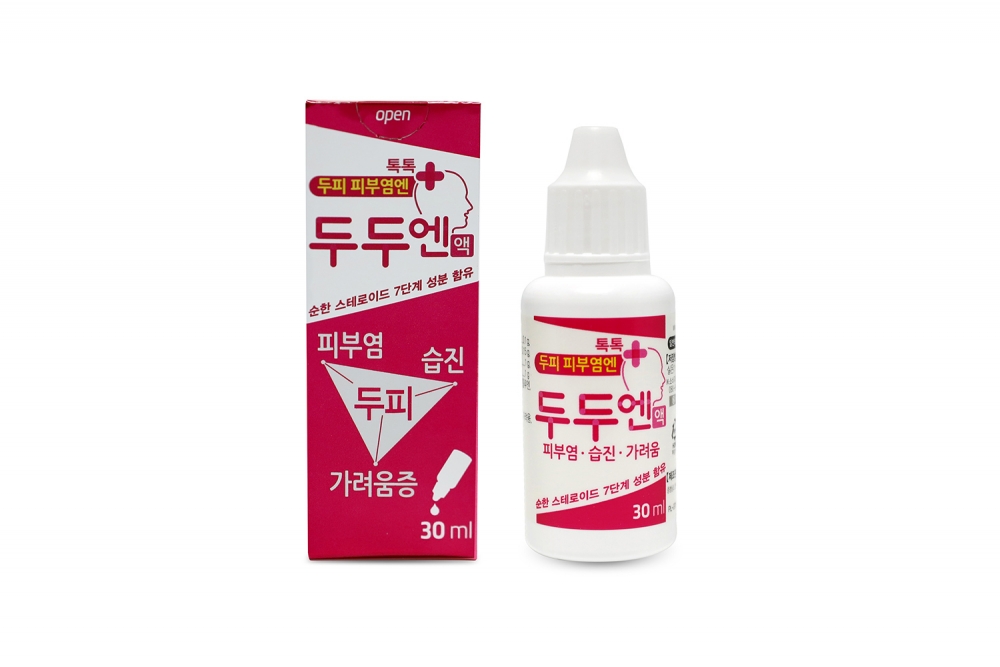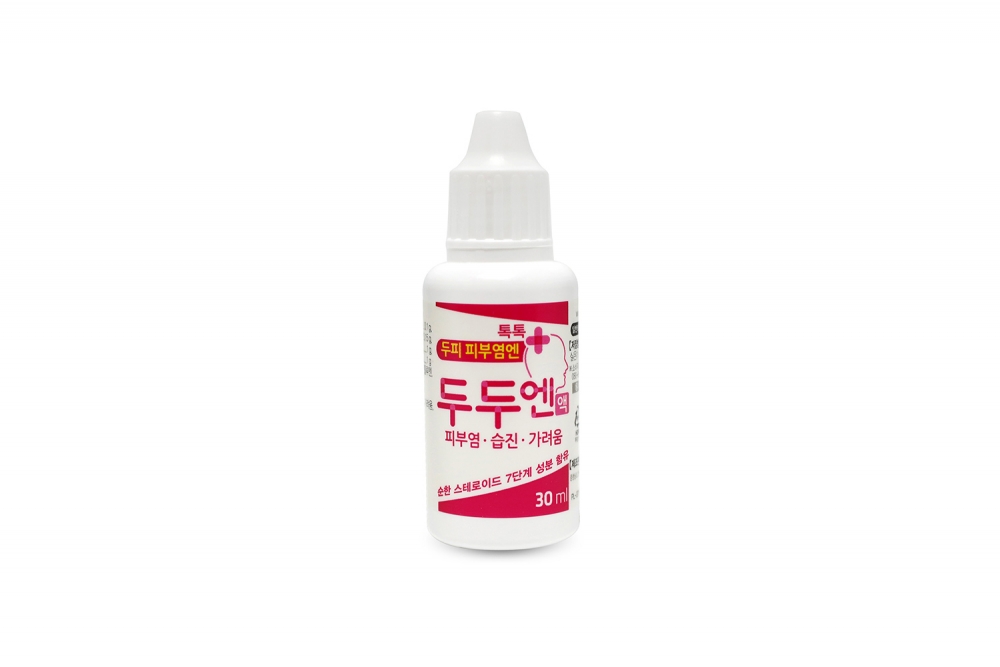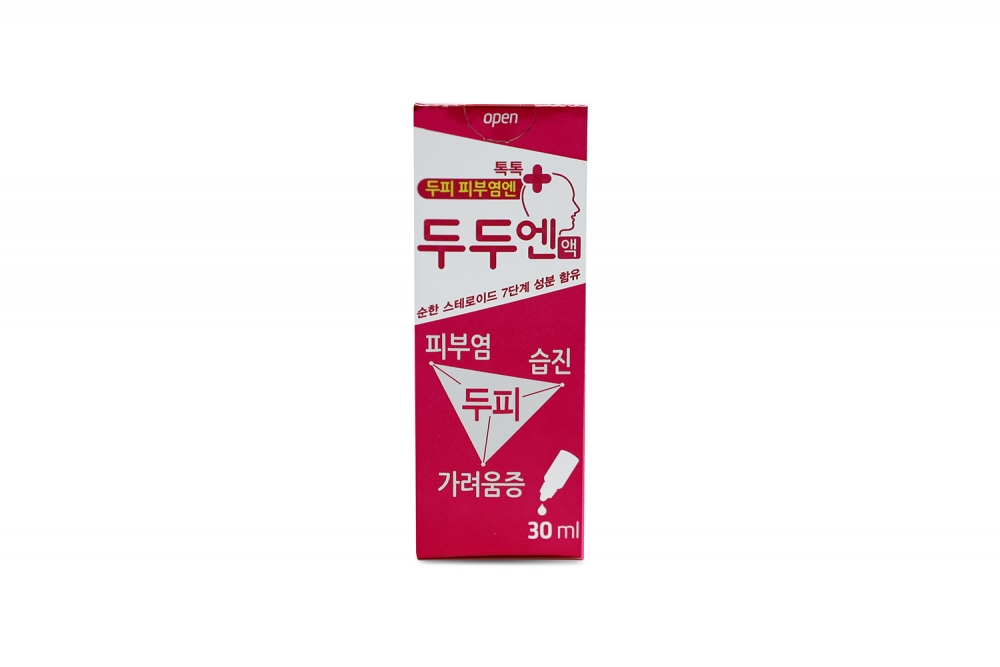A company whose utmost priority is human health and well-being
General Medicine
General Medicine
Duduen Liquid
- Product classification
- General medicine
- Classification by efficacy
- Pain relief/rupial/convergence/anti-inflammation agent
- Specification
- 30ml
- Use period
- 24 months
- Storage method
- Sealed container, store at room temperature (1∼30℃)?
- Usage · Dosage
-
Apply an appropriate amount to the affected area several times a day.
- Ingredients · Content
-
L-Menthol 3.5g, DL-Campor 1g, defenhydramine hydrochloric acid 1g, timol 0.1g, frednisolone valeroacetate 0.15g per 100mL
- Efficacy · Effects
-
Eczema, dermatitis, heat rash, itching, insect bites, hives
- Efficacy · Effects
-
1. Do not take (use) this medicine if you are one of the following:
1) A person with bacterial (skin tuberculosis, syphilis, etc.), fungus (candidosis, tinea, etc.), viruses (sheath, simple herpes, chickenpox, laryngitis, etc.), animal (ohms, squads, etc.), and skin infections (symptoms may worsen)
2) A person with a history of hypersensitivity to the ingredients of this medicine
3) A person with eczema exeroditis with eardrum perforation (healing delays and infections may occur on the perforation)
4) A person with ulcers (excluding Bechet disease), burns or frostbite (skin regeneration may be inhibited and treatment may be delayed)
5) A person with gastric dermatitis, common acne, and who just received an injection
6) An infant less than 30 months old
2. Do not do the following while taking (using) this medicine.
1) It should not be used for eczema, wounds, or sensitive skin that involves skin infection.
2) In principle, it should not be used for eczema and dermatitis that involves skin infection, but if it is unavoidable, treat it with an appropriate antimicrobial agent (body application), or consider combination with them.
3) Since systemic absorption of local corticoids can cause reversible hypothalamus - pituitary - adrenal (HPA) axis suppression, cushing syndrome, perglycemia, diabetes, etc., a person who uses local corticoids under extensive body surface or sealed bandages regularly measure cortisol concentration or HPH.
4) If the HPA axis has been suppressed due to the systemic absorption of local corticoid, try to stop the use, reduce administration frequency, and replace it with less active corticoid. In general, HPA axis function recovers quickly after local corticoid medication stops.
3. The following person should consult their doctors, dentists and pharmacists before taking (using) this medicine.
1) A person who has experienced allergic symptoms (e.g., rash, redness, itching, lacquer poisoning, etc.) from using drugs or cosmetics.
2) A person who or whose family member is allergic
3) A person with severe wetting, crushing, or inflammation
4) A person under medical treatment
5) Children
- The medicine can cause convulsions.
- Children have a larger percentage of their body surface area per weight than adults, so they are more likely to develop HPA axis inhibition, Cushing syndrome, and developmental disorders due to corticoid.
6) Pregnant or possibly pregnant women
- Since safety for pregnant women is not established, extensive use by pregnant women or women who are likely to be pregnant should be avoided in bulk or over a long period of time and given only if the therapeutic benefits are deemed to exceed the risk
7) Breast-feeding women
- It is not known whether locally administered corticoids are transferred to breast milk, but care should be taken when administered to lactation as whole-body administered corticoids are transferred to breast milk.
8) Older people
- Generally, abnormal reactions are likely to occur in older people, so be careful when using large amounts for a long-term extensively (especially sealing bandage).
4. Stop taking (using) this medicine immediately and consult your doctor, dentist or pharmacist if the following happens. Bring this attached document to the consultation, if possible.
1) Skin
- Infection: Bacterial properties of the skin (contagious agar, hair follicle, etc.) and fungal properties (candasia, tinea etc.) and viral infections (likely to happen with the use of sealed bandages) If such symptoms occur, use appropriate antimicrobial agent or anti-fungal agent together, and if the symptoms do not improve quickly, stop using them.
- General skin symptoms: hair follicle, swelling, skin irritation, irritation, fever, rash, redness, itching, skin dryness, pustular dermatitis, allergic contact dermatitis, heat rash, mamilaria, wound deterioration, bedsore, and pustulosis. If such symptoms occur, stop using the medicine.
- Long-term use: steroid acne, steroid skin (skin contraction, capillary expansion, placenta), steroid injection, gastric dermatitis (redness, oral, capillary dilation, scab, laryngeal), childhood skin changes, polymorphic, pigmentation, striatal, and atopic dermatitis. In the event of these symptoms, the dosage should be slowly reduced and the medicine should be replaced with a medicine without the corticoid content.
2) Endocrine system: Use extensively or over a long period of time, sealing bandage method may inhibit pituitary and adrenal cortex functions such as corticoid system administration.
3) Eye: Be careful as it may increase the pressure of the eye and cause glaucoma. Extensive use in bulk or over a long period of time, sealing bandages may result in posterior cataracts, glaucoma, etc. Uncertain visual obstruction may occur.
5. Other precautions when taking (using) this medicine
1) If symptoms are not improved after 5-6 days of use, stop using it and consult a pharmacist or doctor.
2) If symptoms improve, stop using it as soon as possible.
3) Follow the specified usage and dosage.
4) When it is used for children, it should be used under the guidance and supervision of the guardian.
5) Use this medicine only for external use and do not swallow or inhale it.
6) Do not use it on the eyes, around the eyes, or in the mucous membrane, etc. Be careful not to let this medicine enter the eyes. If it gets into your eyes, wash it immediately with water. If the symptoms are severe, seek medical attention from an eye doctor.
7) Wash the liquid on your hands well because it can irritate the mucous membrane of your eyes.
8) Do not use the sealing bandage method without the supervision of a doctor (when using the sealing bandage method, it is easy for bacterial infection to occur, so clean the affected area before application).
9) Be careful as diapers, etc. can cause the same effects as the sealing bandage method.
10) Do not use it for any purpose other than treatment, such as for make up or shaving.
11) This medicine is liquid, so shake it well before use.
6. Storage precautions
1) Keep it out of reach of children.
2) Avoid direct sunlight and store it in a cool place with less moisture.
3) Taking the medicine out of the original container and storing it in another container may cause accidents or deterioration of the quality of the medicine, so keep it closed tightly in the original container.
4) Do not leave it near the fire.
5) Products that have passed the period of use must not be used.
6) Be careful not to let the medicine touch plastic items such as watches, glasses, painted floors, furniture, etc., as this medicine may deteriorate.
7) Be careful not to use this medicine on dyed hair as it may cause bleaching.




